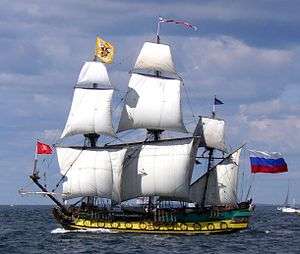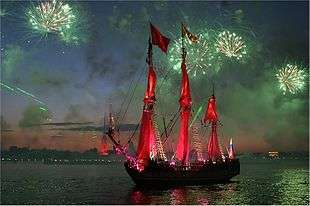Shtandart (frigate)
 Shtandart under sail in Baltic Sea, 2007 | |
| History | |
|---|---|
| Name: | Shtandart |
| Namesake: | Imperial Yacht ship |
| Owner: | Imperial Russian Navy |
| Ordered: | 1703 |
| Builder: | Shipyard of Olonets city |
| Laid down: | April 24, 1703 |
| Launched: | August 22, 1703 |
| Acquired: | September 8, 1703 |
| Commissioned: | September 8, 1703, 1999 |
| Decommissioned: | 1727 |
| In service: | 1710 |
| Out of service: | 1711 |
| General characteristics (typical) | |
| Class and type: | 24-gun (28-gun after 1710 refit) three-masted frigate |
| Displacement: | 220 tons[1] |
| Length: | |
| Beam: | 6.9 m (23 ft)[1] |
| Height: | 33 m (108 ft) mainmast[1] |
| Draft: | 3.3 m (11 ft)[1] |
| Decks: | Berth, Gun, Spar |
| Propulsion: |
|
| Sail plan: | 620 m2 (6,700 sq ft) on three masts[1] |
| Speed: | 11 knots (20 km/h) |
| Complement: |
|
| Armament: | 24 guns (after 1710 28 guns) |
The frigate Shtandart (Russian: Штандартъ) was the first ship of Russia's Baltic fleet. Her keel was laid on April 24, 1703 at the Olonetsky shipyard near Olonets by the decree of Tsar Peter I and orders issued by commander Aleksandr Menshikov. The vessel was built by the Dutch shipwright Vybe Gerens under the direct supervision of the tsar. She was the first flagship of the Imperial Russian Navy and was in service until 1727. The name Shtandart was also given to the royal yachts of the tsars until the Russian Revolution in 1917. Tsar Nicholas II's royal yacht was last of this series.
The replica frigate has three masts and her displacement is 220 tons. She is 25 metres (82.0 ft) long at her centre line, 27.5 metres (90 ft) long on deck and 34.5 metres (113 ft) long overall. The Shtandart is 6.9 metres (23 ft) wide with a draft of 3.3 metres (11 ft). The ship is designed for speeds between 8-9 knots under sail, and under auxiliary engines required by modern standards up to 15 knots (28 km/h). The original crew complement in 1703 was between 120 and 150, and the modern crew consists of 30 trainees and 10 officers.
The First Shtandart (1703)
The name Shtandart signifies Peter the Great's desire to gain access to the Baltic Sea, which at the time of the Shtandart's construction was dominated by the Swedish Empire. A plan to take control of the Baltic Sea away from Sweden was revived after Peter's Grand Embassy ended in 1698. The name refers more directly to a naval ensign created for the new Baltic Fleet, of which the Shtandart was the first ship.[2][3] Peter's goal was finally realized after he decisively defeated Swedish forces at the Battle of Poltava[4][5] in 1709, a turning point for Russia in the Great Northern War (1700–1721).
The Shtandart's design combined techniques from English and Dutch shipbuilding schools. The frame of the ship is wide, almost square, and the ship's double bottom is flat, reducing the draft. The high rigging of the sails is in the English style. The frigate was launched on August 22, 1703 and set sail on September 8, 1703 for St. Petersburg.
The Shtandart and Peter I
The Shtandart was built in only five months, and Tsar Peter I's personal involvement may have expedited the construction. Peter had learned shipbuilding techniques from the Dutch during his Grand Embassy tour of western Europe (1697–98), and he sailed on the Shtandart as its captain under the pseudonym Peter Mihajlov on its maiden voyage from Olonets to Saint Petersburg in September 1703.

In the great cabin there is a compass hanging over a table which can only be read from its underside. A Russian legend relates that this compass hung over Peter's hammock and that when he woke up, he always checked the compass to ensure that the frigate was on course.
Repairs and Breakup
The Shtandart was overhauled in 1710 and four cannons were added to her armament, making her a 28-gun frigate. The ship was laid up in drydock in 1711 to have several beams replaced. In 1727 Catherine I ordered a survey of the frigate to determine if she was sound enough for another refit. During an attempt to raise the ship above the waterline, the hull was cut in half by cables used in the process. The Shtandart was broken up, and Catherine ordered a replacement to be built. This order was finally carried out in 1994.
The Modern Replica (1999)
In 1994 a small group of sailing enthusiasts led by Vladimir Martus started construction of a replica of the ship. Martus developed a new layout of the Shtandart wherein she was built with four bulkheads, dividing her into five compartments. The "Shtandart Project" (a non-commercial organisation dedicated to youth development) launched a replica of the frigate on September 4, 1999. The modern Shtandart has two zones:
- The historically accurate area above the gun deck: the steering wheel and helm, all decorative carvings, the furniture, and all of the masts, spikes, guns, gangways and hatches are carefully reconstructed.
- The "modern" area built to modern standards and in compliance with safety regulations: This includes two Volvo Penta TAMD 122P engines and a generator.

Milestones of the Shtandart
- On September 4, 1999 the Shtandart was launched at the Petrovsky Shipyard in St Petersburg.
- In June 2000 the Shtandart set sail on her maiden voyage. The frigate retraced the route taken by Peter I, during his Grand Embassy.
- Since 2005, the Shtandart has played the part of the "dream ship" at the Scarlet Sails festival, an annual celebration of the end of the school year in St. Petersburg from a novel by Alexander Grin[6][7]
- Over the last ten years the Shtandart has sailed approximately 55,000 nautical miles (102,000 km) in the Baltic, North, Norwegian and Barents Seas. She has visited fifty ports in eleven European countries.
Bureaucratic difficulties
Beginning in 2007, all sailing vessels in Russia faced problems with safety certification. The new National Sea and River Authority (then Росморречнадзор/Rosmorrechnadzor, now Госморречнадзор/Gosmorrechnadzor) refused to issue certifications for sailing ships. The Shtandart was one of the most prominent of these vessels, so her dispute with this government agency was widely publicized.[8] The Northwest directorate of the Rosmorrechnadzor cancelled the Shtandart's certifications but the St. Petersburg Arbitration Court reversed the decision favor of the frigate, and the cancellation was ruled illegal.[9] The ship has now been sailing around in Europe for the last few years without plans to return to its home port, to avoid red tape problems.
Shtandart's activities in 2009–2014
- On July 24, 2009 the Shtandart obtained an operations permit and planned to participate in the Tall Ships' Races Baltic 2009 to Kotka and Klaipeda.[10] Bureaucratic red tape delayed its departure from port until August 1, 2009.[11]
- On August 25, 2009 the Shtandart sailed around Norway's North Cape.
- During the winter of 2009–2010, the ship remained in Oslo, Norway, for winter quarters.
- The Shtandart took part in the Sail 2010 tall ships' festival in Bremerhaven, Germany between August 25 and 29.
- The Shtandart took part in the Royal Greenwich Tall Ships Festival in London, UK between September 5 and 9.
References
- 1 2 3 4 5 6 7 "Ship Characteristics" (in Russian). Shtandart. Retrieved 2009-09-11.
- ↑ Russian Naval Ensigns from the Flags of the World site.
- ↑ Translation of page from Russian Navy website showing similar historical ensigns.
- ↑ Battle of Poltava (Wikipedia)
- ↑ Battle of Poltava (Encyclopedia of Ukraine website)
- ↑ Brief description of "Scarlet Sails" celebration and other holidays.
- ↑ another "Scarlet Sails" link (Russian).
- ↑ Pirogovsky, Artem (2008-07-10). "Владимир Мартусь: Причина конфликта ""Штандарт" vs Росморречнадзор" - слишком большая сумма контракта" [Vladimir Martus: the Reason for the conflict "Shtandart" vs Rosmorrechnadzor "- too great a contract sum]. Mediaconflict (in Russian). Lenizdat. Retrieved 2009-09-12.
- ↑ Gazeta article about the case.
- ↑ "Shtandart" is out to sea (Russian)
- ↑ "Shtandart" puts out to sea after another delay."
External links
| Wikimedia Commons has media related to Shtandart (ship, 1703). |
- Official Shtandart website (Russian)
- Official Shtandart website (English)
- Shtandart on the Marine Traffic AIS tracking service

.jpg)